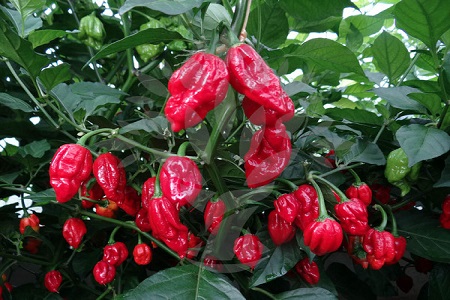
We Export The Best Quality Naga Morich (Bhut Jolokia)
The Naga Chili, closely related to the Bhut jolokia, is a chili pepper cultivated in Bangladesh and North East India. It is mostly very similar to Bhut Jolokia, or Ghost Chilli. In the UK it is called Dorset Naga which is originally from Bangladesh. It is one of the hottest known chilli peppers.
Like many varieties of the Chinense species, the Naga Chili is a small to medium shrub with large leaves, small, five-petaled flowers, and blisteringly hot fruit. It differs to the Bhut Jolokia and Bih Jolokia in that the pods are slightly smaller with a pimply ribbed texture as opposed to the smoother flesh of the other two varieties.
Use of Naga Morich (Bhut Jolokia):
The Naga Chili is extremely hot, but has a flavor that is quite unique.
Many specialists say that the Naga Chili is as spicy as Rafi and like the Bhut Jolokia (Ghost Pepper), it has a sweet and slightly tart flavor, followed by slight undertones of woody, smoky flavors. The chili is traditionally used green by the Bangladeshis, often eaten raw as a side dish. It is well suited for BBQ and grilling due to its unique flavor profile.
Cultivation of Naga Morich (Bhut Jolokia):
1. Sow the chilli Seeds:
If you can get your hands on a specialist chilli germinating solution then so much the better, if not, don’t worry. Take a standard seed cell tray and fill with a mixture of good quality seed compost and a handful of fine vermiculite to aid drainage. Moisten with water and place in a propagator to warm the soil. Note: If you live in a cold climate you will need an electric propagator as you will have to sow the seeds in late January. Chillies need a long growing season, you cannot wait for the weather to change. Sow the seeds one per cell, cover with compost and keep moist, ensure a regular temperature is maintained.
2. What to do when the chilli seeds have germinated:
This is an important time, if the chilli seeds germinate too quickly,i.e ’shoot up’ with a long thin stem then you might be in trouble. Too much heat and not enough height can be problomatic. Make sure the seedlings have plenty of natural light where possible, use alternative heat lamps if need be. If the seedlings seem to be straining towards the light then turn them around and try and expose them to more light, they should grow straight and true. To avoid ‘bolting’ decrease the heat during the day and increase during the night as the temperature drops, but try and maintain an even temperature.
3. Potting the seedlings on:
Don’t be in a rush to transplant the young seedlings into a larger pot, they’ve got months of growing ahead of them so wait until they are well established in their individual cells. Repeat the process with the warm soil and vermiculite mixture, don’t shock the tender seedlings by putting them into cold compost. Use a 7″ plant pot or similar, keep the light source constant and watch out for sudden fluctuations in temperature. If you have a warm greenhouse/conservatory then so much the better. Leave these in their pots for at leat another month or until the roots just begin to show at the bottom of the pot. Keep moist but do not overwater.
4. Potting chillies into their final growing position:
Hopefully you will now have healthy chilli plants in small pots. Now is the time to transfer them into their final growing place. This depend upon your circumstance, it might be a large pot, growbag, polytunnel or outside if you live in a hot climate. Wherever you are the plants need heat, if you live in a cool climate such as England then you will have to grow them under glass. If you live in a country with six months of fine sunshine then plant them outside.
5. How to Pollinate Chillies by hand:
Place a bowl of water by the plants and leave to come to temperature. Take a fine paintbrush and dip in the warm water. Gently dab the flowering heads with the brush to aid pollination, the jolokia’s need this more than other chilli varieties, particularly if you are growing under glass.
6. Feeding chilli plants:
Gradually increase the feeding to twice a week as the plants grow, don’t worry if the plants dry out a little in between watering. Rough, hot conditions suit the hotter strains of chilli and the strength of the chilli heat will be affected by this. Basically, mother them until they are in their final growing place and then treat them a bit rough. Damp your greenhouse and/or plants down during hot spells.
7. Harvesting your chilli plants:
If you want to increase the yield of your plants then pick some whilst still green, use scissors and cut them cleanly. Leave the rest to mature on the plant, the heat increases with the maturity of the fruit, if the climate is right they will continue to ripen into the winter months.
Hope this is of some use, if you manage to get through the cold spell trouble free then you should be in for a ‘home run’. Chillies are fun to grow and rarely prove troublesome.





